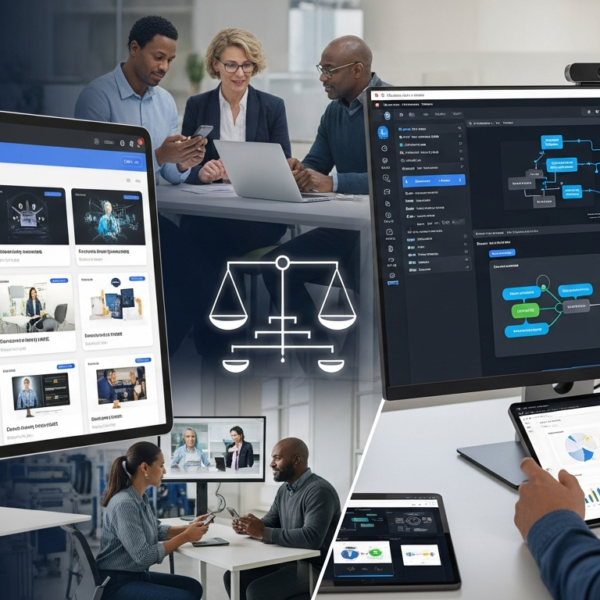Taibi Kahler, creator of the model initially intended for NASA, distinguishes 6 Perceptions, six “filters” from which we observe the world, analyse information and perceive reality:
Factual Thinking, which is based on facts and logic;
Opinion, which is based on personal opinions and convictions;
Emotion, which is based on emotions and feelings;
Reaction, which is based on play, complicity and spontaneous expression;
Action, which is based on action and its benefits;
Imagination, which invites reflection through the prism of imagination.
These 6 Perceptions are associated with what PCM® calls the 6 Types of Personalities. The nuance here, compared to other meta-models, is that you are not this or that type. Your “Personality Structure” (imagine a 6-storey building to represent this structure), which develops in childhood, is made up of a unique mix of the 6 Perceptions mentioned above.
According to your singularity, you will express behavioural characteristics that are specific to you, with dominants based on this structure (the 1st floor represents your Privileged Perception, your comfort zone, the 6th being the least perceptible in your behaviour and mode of communication).
If, like me, you are convinced by the relevance of this model for any transmission exercise, it becomes interesting to ask yourself the question: how can a digital training module be designed to appeal to, engage and encourage the retention of the knowledge dispensed to a maximum number of learners?
Because the digital constraint is there: we are not in front of our trainees. We don’t feel the room, its energy, the degree of adherence. It seems difficult to adapt to the singularity of individuals, as we would do in face-to-face training.
To address this challenge and to offer a memorable Learning Experience, I propose the following practical tools that I use with VTS Editor: designing an e-Learning module that uses the 6 Perceptions as theorised by Process Communication Model®:
1. Factual Thinking Perception – Structure Information and Time
A learner who bases his learning style primarily on facts and logic will need access to theoretical information and the ability to structure his time:
- Access to the inventory: the inventory is a cornerstone in terms of the mechanism of gamification in the world of video games; the same applies to training that uses these same mechanisms. Allowing the learner to access it at any time, or at times chosen by you according to the pedagogical objective, will enable him/her to clearly structure his/her thinking before proceeding to the top-down information stages and practical exercises.
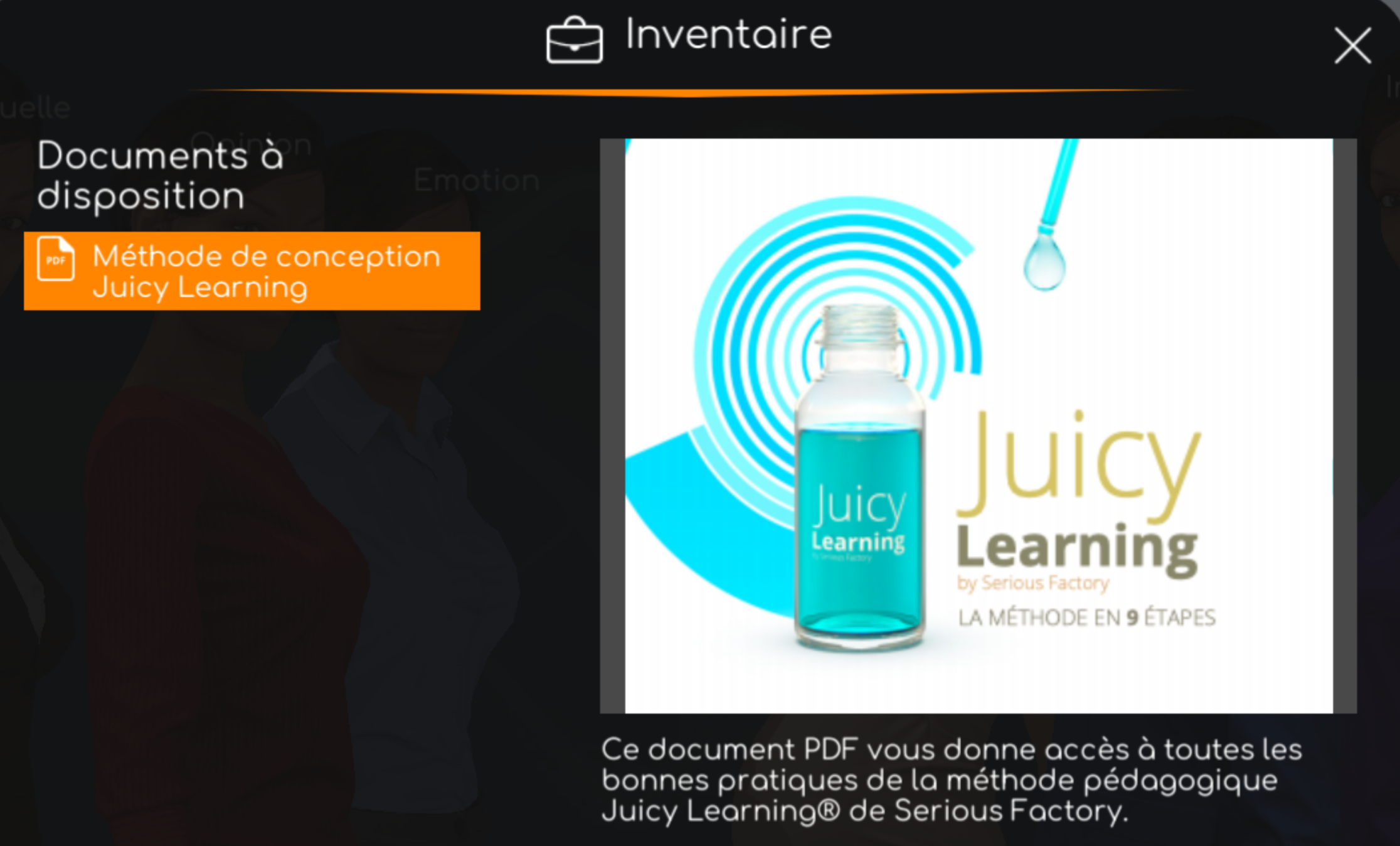
Access more information about the Inventory Block in VTS Editor.
- Time structuring: allowing the learner to project himself in time encourages his commitment. It also removes the stress of “knowing when to start, not when to finish”. Although it is not essential to include the notion of temporality (stopwatch, timer, countdown timer) systematically throughout an educational scenario, temporal anchors accentuate the learner’s concentration and maximise the retention of the content provided.
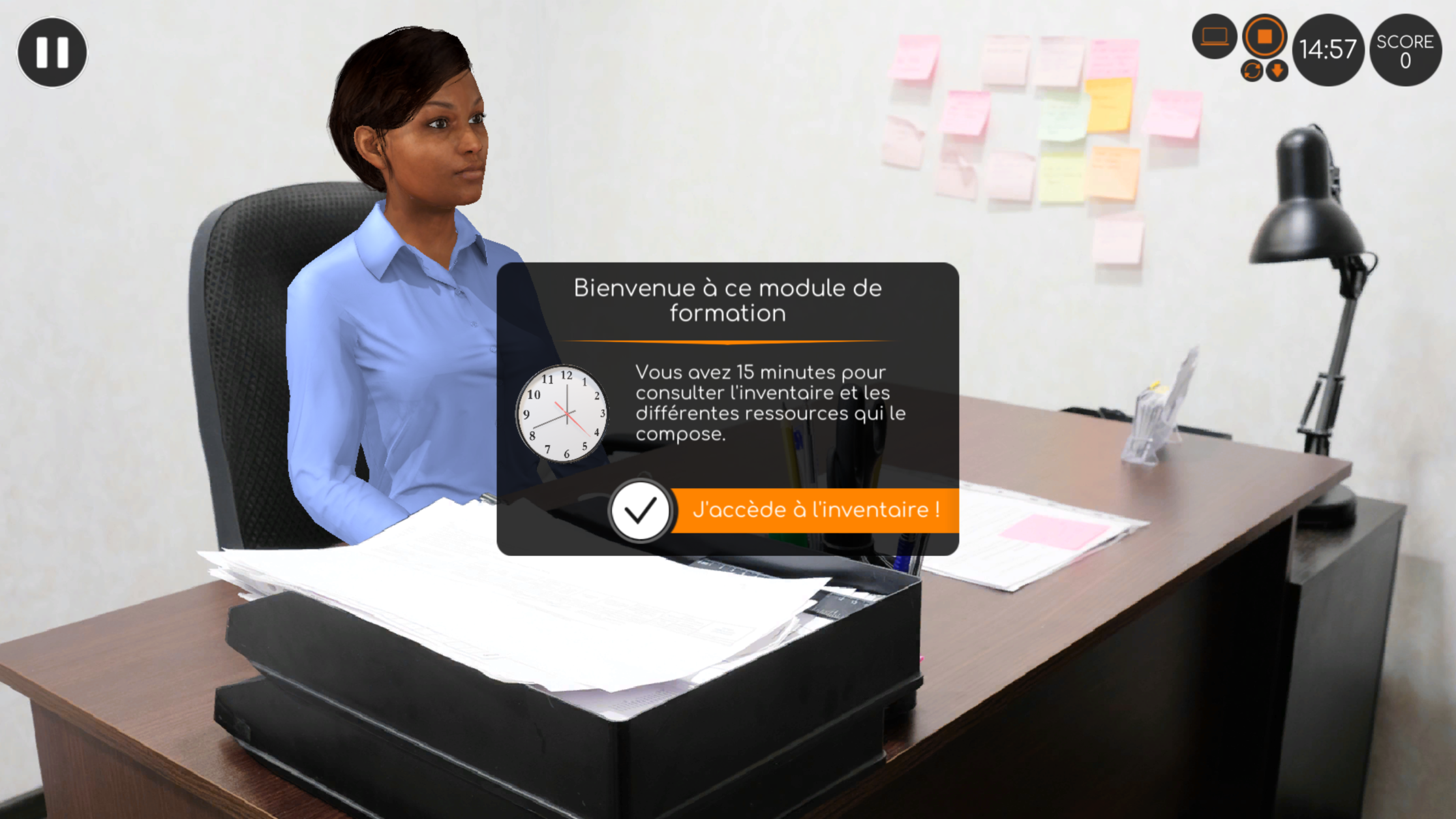
2. Opinion Perception – Express yourself and provide a space for expression
I call this “two-way interactivity”: express your point of view, your frame of reference, your business expertise as a trainer, while providing a space for your learners to express themselves. Bring value, and accept value in return, by making your digital training systems as humane as possible:
- Video Learning: the “human” is particularly important in a digital environment. Use the Video Learning approach without restricting it to learning technical gestures; embody yourself, the management or the teams in this virtual space that you offer your learners and share orally the approach, the principles and the targeted teaching objectives.

- Forms: if you are unable to exchange information instantly in person, offer your learners the opportunity to give feedback to assess their satisfaction, for example, or to express themselves using the free form field. The use of Variables and Conditions can be used to identify key words within this free input that will trigger paths for the learner in a tree structure and which you can then analyse in a detailed and qualitative manner, in order to be as close as possible to his or her training needs.
3. Emotion Perception – Stimulate the senses and promote emotional response
Morgan Brown and Chuck Longanecker explain that by targeting the visceral response, we can deliver emotional satisfaction and boost commitment. While the article focuses on design, the principle remains relevant to the Learning Experience in its digital form. So how do we trigger this emotional reaction/satisfaction in Digital Learning?
- Juiciness : Juicy Learning® offers the opportunity to draw inspiration from the codes of the video game for digital learning with the aim of engaging 3 of the 5 senses:
- Sight: offer realistic or unrealistic environments that immerse the learner thanks to aesthetic and recurring visual stimuli;
- Hearing: dialogues, background music, sound effects…;
- Touch: interactivity must go further than simply clicking on a button to access the next slide; it must trigger high-stakes situations, which stimulate concentration, through sound, visual and situational responses.
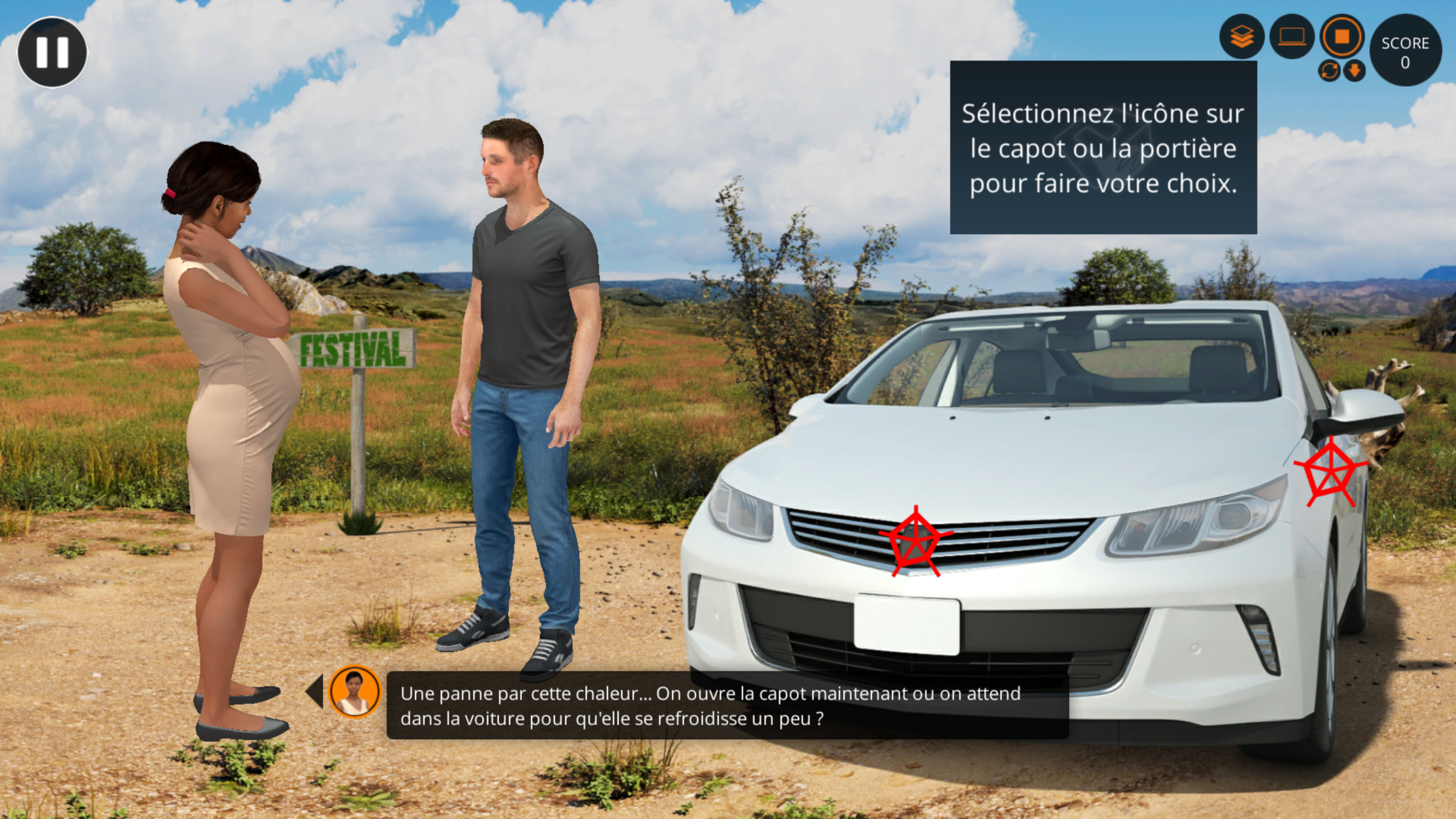
- Verbal and non-verbal:: : whether we like it or not, we are beings governed by the ego, and tend, more often than not, to feel emotions through the filter of the consciousness we have of ourselves; on a macro scale: of human beings. So how can we “humanise” the digital? The verbal and the non-verbal!

In the photos above, on the left we feel the emotion of sadness on the face, on the right of joy, and this is through the facial expression and the body posture of the character, his non-verbal. A vocal actor will perfectly know how to transmit the emotion of the other character, through the nuances of his verbal expression: tone of voice, tonic accents, volume, etc.
4. Reaction Perception – Design gamified modules and make the experience unique.
There are many levers that can promote the development of skills, among them the fact of learning while having fun and the feeling of living a singular pedagogical experience that does not seem generic and “one size fits all”. Or when the book of which you are the hero meets playfulness!
- Gamification: a treasure hunt in the form of a cause tree where the learner takes on the role of an investigator starting from a problematic situation for which he must find the causes. The principle of the guardian angel where the learner, as a real Jiminy Cricket, will follow the daily life of a character confronted with situations by advising him while assuming the consequences of his advice. A mix of cartoon and realistic characters. Obtaining coloured badges to recognise progress. There are many and varied examples of gamified screenplays. The only watchword: have fun and offer pleasure by using your creativity!

- The tree-like scenario: in educational design, we often oppose linear scenarios (the syndrome of “I answer the quizzes and click on the arrow pointing to the right to access the next slide”) to tree-like or non-linear scenarios. The latter, by means of branches, offers the learner the possibility of navigating through the scenario as he or she wishes, or almost. Perception Reaction can only be nurtured if there are surprises, the possibility of making choices that resemble us, or even of choosing at all. This non-linear approach to digital training allows the learner to be, to a certain extent, himself, with the feeling of doing what he wants. To live a much more personalised experience than they are used to.

Example: the picture above is from an EduMarket Game made with VTS Editor. You can visit each system (representing a company’s business units), in the order of your choice, in order to make financial investment choices in favour of the Customer Experience. The choices have an impact on the final result via different KPIs. Or how to combine fun and strategic issues!
5. Action Perception – Put your learners in action and reward them
A few months ago, I published an article on ELM, “experiential learning” as developed by David A. Kolb and Ron Fry. In it, I explain, among other things, how to offer a concrete and applied experience in digital form because, indeed, some learning populations seem to be impervious to the notion of being able to develop skills behind a screen. So how can we nurture a predominant Perception Action?
- Immersive simulation: living a virtual everyday professional situation thanks to an immersive simulation with a first-person view, remains the shortest path between digital training and field experience. The learner is no longer passive, he becomes an actor in his training and this changes absolutely everything. Here are a few tips to give your learner the feeling of being truly immersed in his or her profession:
– Select plausible characters or customise them your colours (uniforms, accessories or even morphologies);
– Recreate his professional environment with a set configurator;
– Vocalise your teaching modules with human or realistic voices if they are synthetic;
– Build the sound environment with sound effects and other ambient sounds appropriate to the setting in question (shop, building site, hospital, offices, school, etc.).
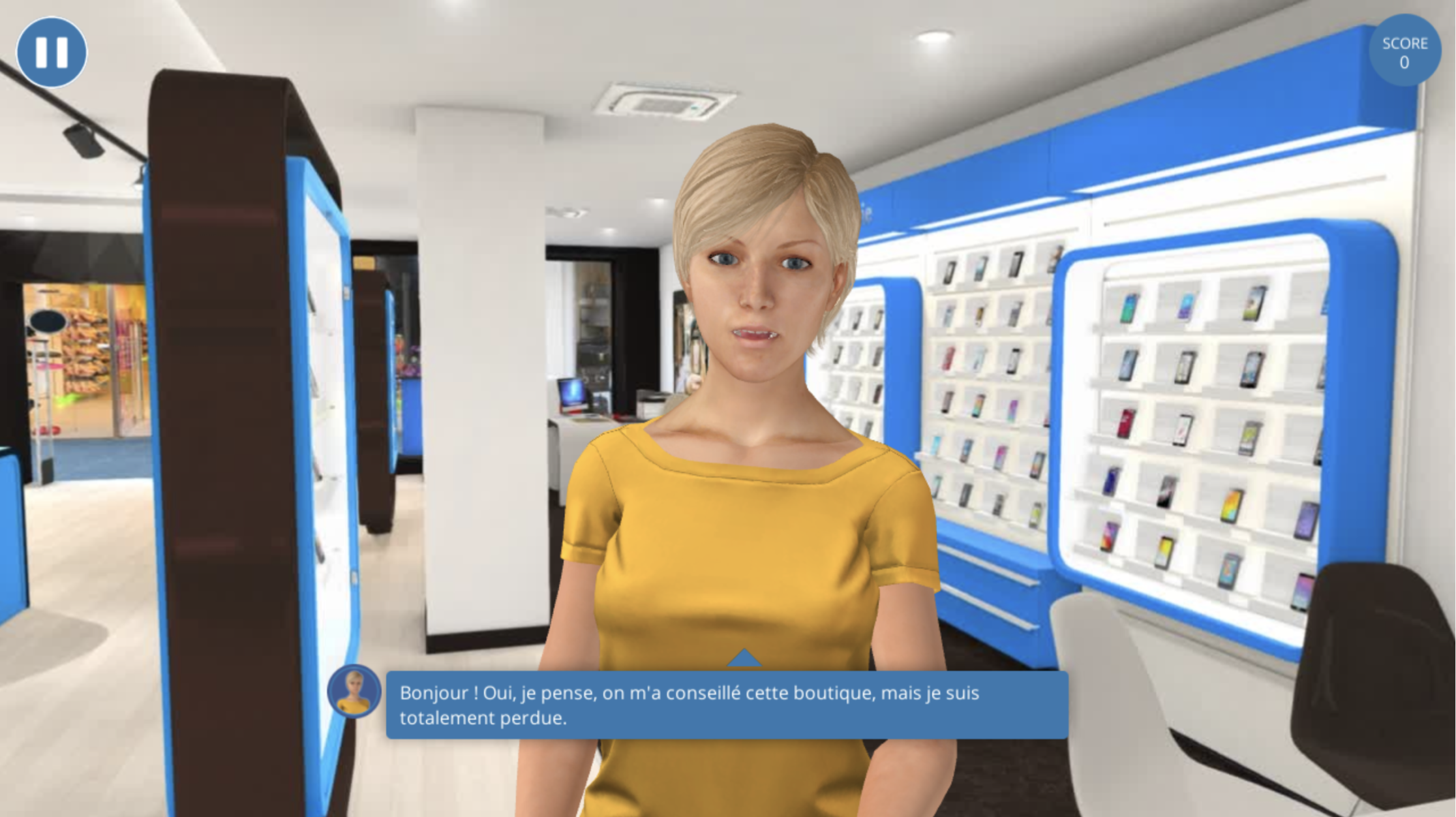
- WIIFM : What is it? This is the acronym “What’s In It For Me? “(the equivalent of “What’s In It For Me?” in French). Because yes, the need for gratification is important in training too. Whether it’s a need for recognition or socialisation, training in itself cannot be the only motivating factor in engaging the learner, at least not all learners, because we will have understood that we are not all the same in our dominant perceptions. For my part, I like the leaderboards!
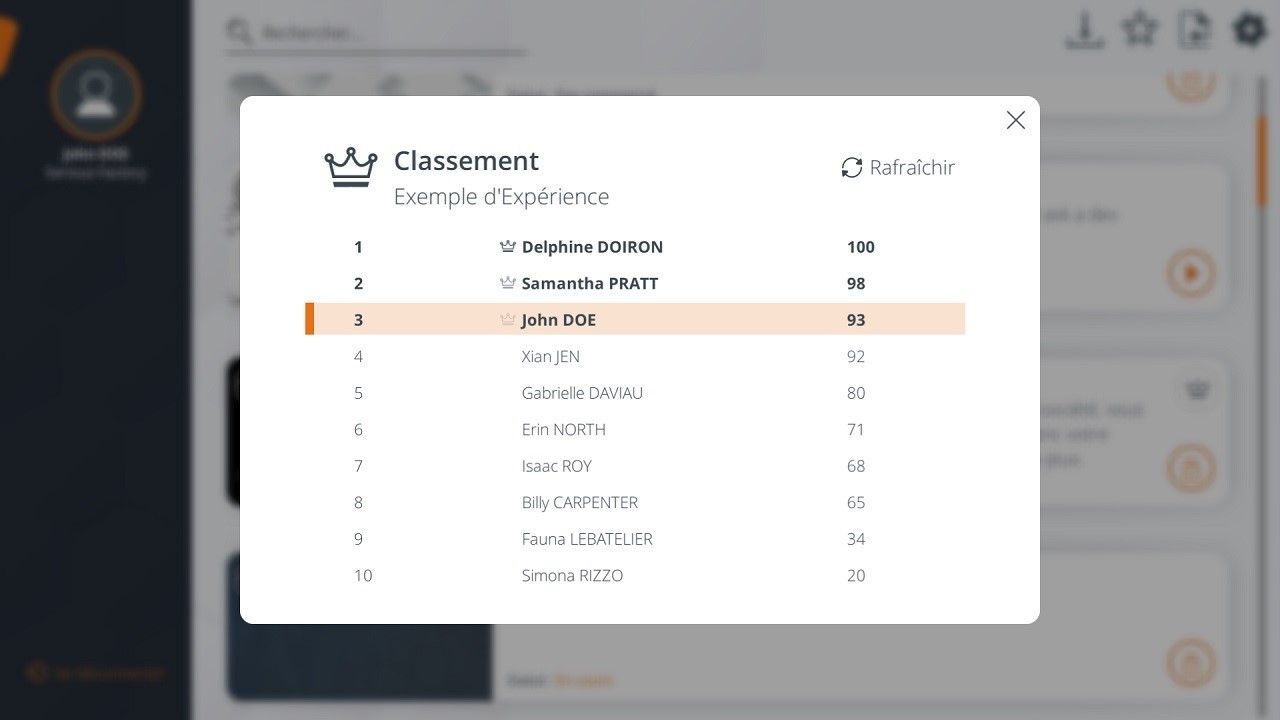
It’s up to you, designers-trainers, to imagine the best way to reward your learners, depending on the means, collective agreements and culture of the companies concerned.
And speaking of imagination: it would not be a credit to Perception Imagination to offer you any kind of practical tool. Because it is your imagination that will make all the quality, personal and unique, of your achievements.And speaking of imagination: it would not be a credit to Perception Imagination to offer you any kind of practical tool. Because it is your imagination that will make all the quality, personal and unique, of your achievements.
Instead, I invite you to download VTS Editor and imagine for yourselves the best approaches to engage your learners’ 6 Perceptions, and build, for them, an exceptional teaching experience!







